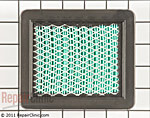
- 1-877-650-2121
- My Orders
- Cart 0 item(s)

The most common problems with lawn mowers after the off-season or winter can be prevented with proper preparation before storage.
Here's a handy checklist to answer the common question, "How do I prep my lawn mower for winter storage?"
 If the blade is bent, replace it, as a bent blade is a safety issue and can cause premature wear to the engine or spindle bearings. Similarly, a blade with dents or gouges should be replaced. A damaged blade may increase risk of debris such as pebbles from being propelled at high speeds through the air. A dull blade tears grass, rather than cuts, providing a dried-out, brown look to the lawn. A blade that has already been sharpened twice should be replaced.
If the blade is bent, replace it, as a bent blade is a safety issue and can cause premature wear to the engine or spindle bearings. Similarly, a blade with dents or gouges should be replaced. A damaged blade may increase risk of debris such as pebbles from being propelled at high speeds through the air. A dull blade tears grass, rather than cuts, providing a dried-out, brown look to the lawn. A blade that has already been sharpened twice should be replaced.
 A clean air filter is critical to the health of the lawn mower, as it blocks dust, dirt and debris from entering the carburetor and engine. Dirty pleated, paper air filters must be replaced. However, hot water and a minimal amount of detergent can be used to clean a foam air filter. Remember to make sure the filter is completely dry before returning it to the lawn mower. If tears or other damageare found on the filter, though, you'll need to replace it. Fuel filters cannot be cleaned; they should be replaced at least once per season.
A clean air filter is critical to the health of the lawn mower, as it blocks dust, dirt and debris from entering the carburetor and engine. Dirty pleated, paper air filters must be replaced. However, hot water and a minimal amount of detergent can be used to clean a foam air filter. Remember to make sure the filter is completely dry before returning it to the lawn mower. If tears or other damageare found on the filter, though, you'll need to replace it. Fuel filters cannot be cleaned; they should be replaced at least once per season.
 Lawn mower manufacturers vary in their instructions about draining or leaving fuel in the engine over an extended period. Read the owner's manual for model-specific information. If your lawn mower manufacturer recommends leaving fuel in the engine, be sure to use fresh fuel treated with fuel stabilizer to prevent clogging in the carburetor.The most common cause of a lawn mower failing to start after storage is a carburetor clogged with buildup caused by stale fuel. That's a fairly time consuming and expensive fix so it's best to do this step right.
Lawn mower manufacturers vary in their instructions about draining or leaving fuel in the engine over an extended period. Read the owner's manual for model-specific information. If your lawn mower manufacturer recommends leaving fuel in the engine, be sure to use fresh fuel treated with fuel stabilizer to prevent clogging in the carburetor.The most common cause of a lawn mower failing to start after storage is a carburetor clogged with buildup caused by stale fuel. That's a fairly time consuming and expensive fix so it's best to do this step right.
No hibernation for your lawn mower?
If you use your lawn mower year round, continue with the manufacture's recommended regular maintenance including periodic tune ups.